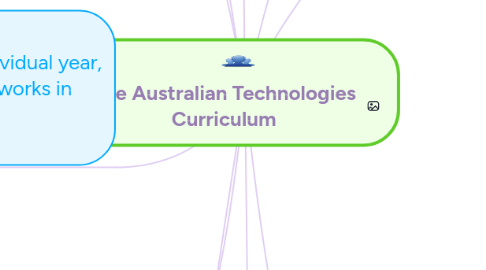
1. Content Descriptors Each brand level has a content descriptor highlighting the knowledge, understand and skills that are expected to be taught and learnt for each band level. They are ordered so that developmental learning is sequenced and knowledge is constantly being developed and expanded rather than repeated.
2. General Capabilites
2.1. Literacy
2.2. Numeracy
2.3. Information and Communication Technology Capability
2.4. Critical and Creative Thinking
2.5. Ethical Behaviour
2.6. Personal and Social Capability
2.7. Intercultural Understanding
3. Key Ideas
3.1. Creating preferred futures
3.2. Systems Thinking
3.3. Design Thinking
3.4. Computational Thinking
3.5. Project Management
3.6. Ethics
3.7. Safety
3.8. Information and Communication technology in the Australian Curriculum
4. Cross-Curricular Priorities
4.1. Aboriginal and Torres Straight Islander Histories and Culture
4.2. Asia and Australia's engagement with Asia
4.3. Sustainability
4.3.1. Sustainability is when students identify a problem, need or opportunity in society. It also is involved when they generate ideas and create solutions when thinking about the environment and everyday life/needs. I.e. A preferred future for them and future generations
5. Student Diversity
5.1. Gifted and Talented Students
5.2. Students with a disability
5.3. English as a second language or dialect
6. Aims
6.1. Students become resourceful and imaginative when using traditional, contemporary and emerging technologies, and understand the differences in technologies over time
6.2. Students are able to assess and evaluate technologies processes to identify and create solutions to a range of problems or opportunities
6.3. Students are able to identfiy, design, manage and create technological solutions
6.4. Students adequately and responsibly select and manipulate appropriate technologies, resources, materials, data, systems, tools and equipment when designing and creating products,
6.5. Students engage confidently with technologies and make informed and responsible decisions about technologies impact on health, social well being, the economy and a sustainable environment.
7. Year Levels/ Band Levels The WA syllabus works with each invidual year, however, the Australian curriculum works in Band Levels These are as follows:
7.1. Year 1 and 2
7.2. Year 3 and 4
7.3. Year 5 and 6
7.4. Year 7 and 8
7.5. Years 9 and 10
7.5.1. The study of technologies in years 9 and 10 are not compulsary. However, it is expected that schools offer technologies course as a preference and that other curriculum areas use technologies in their courses.
8. Achievements Standards The achievement standards outlines the standard of learning that would place the students at an appropriate level for each band. It essentially highlights the learning that students should show at the end of their schooling.
9. Subjects
9.1. Design and Technologies
9.1.1. Strand 1: Knowledge and Understanding
9.1.1.1. Key Concepts 1: Understand the involvement and impact that technologies have on peoples lives.
9.1.1.2. Key Concepts 2: Design concepts across a range of technologies concepts.
9.1.2. Strand 2: Processes and Production Skills
9.1.2.1. Key Concepts 1: Critiquing, exploring and investigating needs or opportunities.
9.1.2.2. Key Concepts 2: Generating, developing and evaluating design ideas for design solutions.
9.1.2.3. Key Concepts 3: Planning, producing and evaluating designed solutions.
9.2. Digital Technologies
9.2.1. Strand 1: Knowledge and Understanding
9.2.1.1. Key Concepts 1: How data are represented and structured symbolically.
9.2.1.2. Key Concepts 2: The components of digital systems: software, hardware and networks.
9.2.1.3. Key Concepts 3: The use, development and impact of information systems in people's lives,
9.2.2. Strand 2: Processes and Production Skills
9.2.2.1. Key Concepts 1: Collecting, managing and interpreting data when creating information, and the nature and properties of data, how it is collected and interpreted.
9.2.2.2. Key Concepts 2: Using a range of digital systems and their components and peripherals.
9.2.2.3. Key Concepts 3: Defining problems and specifying and implementing their solutions.
9.2.2.4. Key Concept 4: Creating and communicating information, especially online, and interacting safely using appropriate technical and social protocols
9.2.3. Resources: Kidblog- http://kidblog.org/home/ Code Kingdom- https://codekingdoms.com/ Hour of Code- https://code.org/learn (Thanks to Courtney Berich) Code.org- https://code.org/ Kids App Maker- http://www.kidsappmaker.com/home Studio Code- https://studio.code.org/ Splash- http://splash.abc.net.au/home#!/home Computational Thinking- http://splash.abc.net.au/home#!/media/1618109/hour-of-code-computational-thinking
